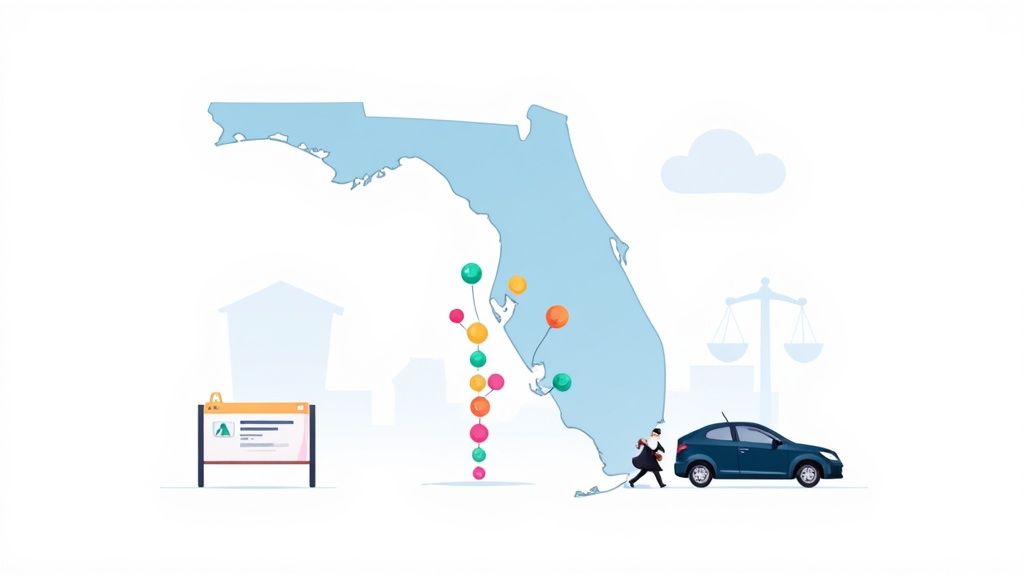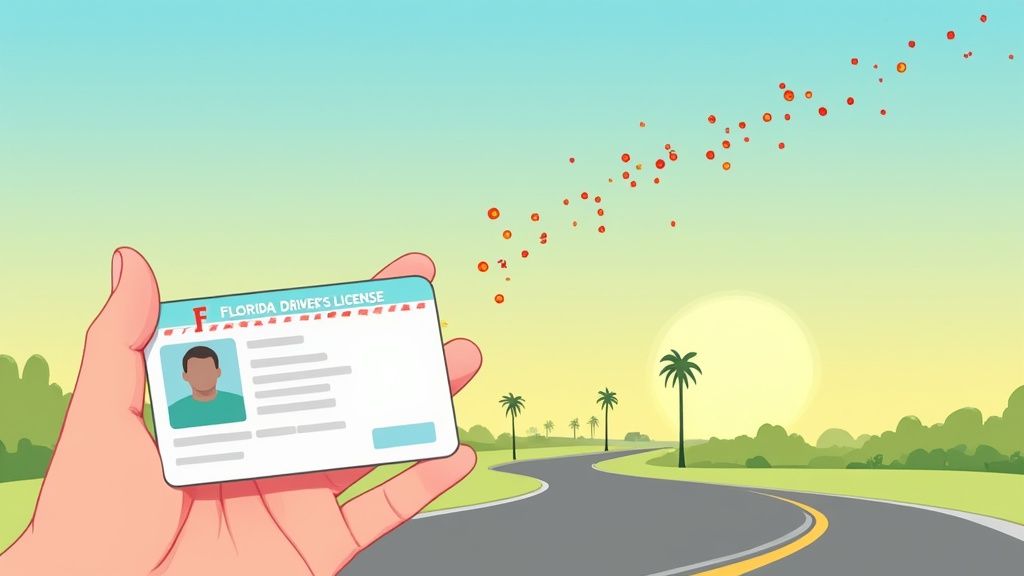Getting your learner’s permit is an exciting milestone for teens eager to hit the road. At DriverEducators.com, we understand the importance of this step in your journey towards becoming a licensed driver.
This guide will walk you through what to expect when obtaining your learner’s permit, including age requirements, application processes, and restrictions. We’ll also cover the transition to a full driver’s license, including our new DETS course in Florida for 15-year-olds.
How Old Do You Need to Be for a Learner’s Permit?
Getting a learner’s permit marks the first step towards driving independence for teens. The age requirements and eligibility criteria differ significantly across the United States, making it important to understand your state’s specific rules.
Minimum Age Requirements
Most states allow teens to apply for a learner’s permit between the ages of 14 and 16. Idaho and North Dakota permit applications at 14, while states like New Jersey and Massachusetts require applicants to be 16. The majority of states set the minimum age at 15 or 15 and a half.
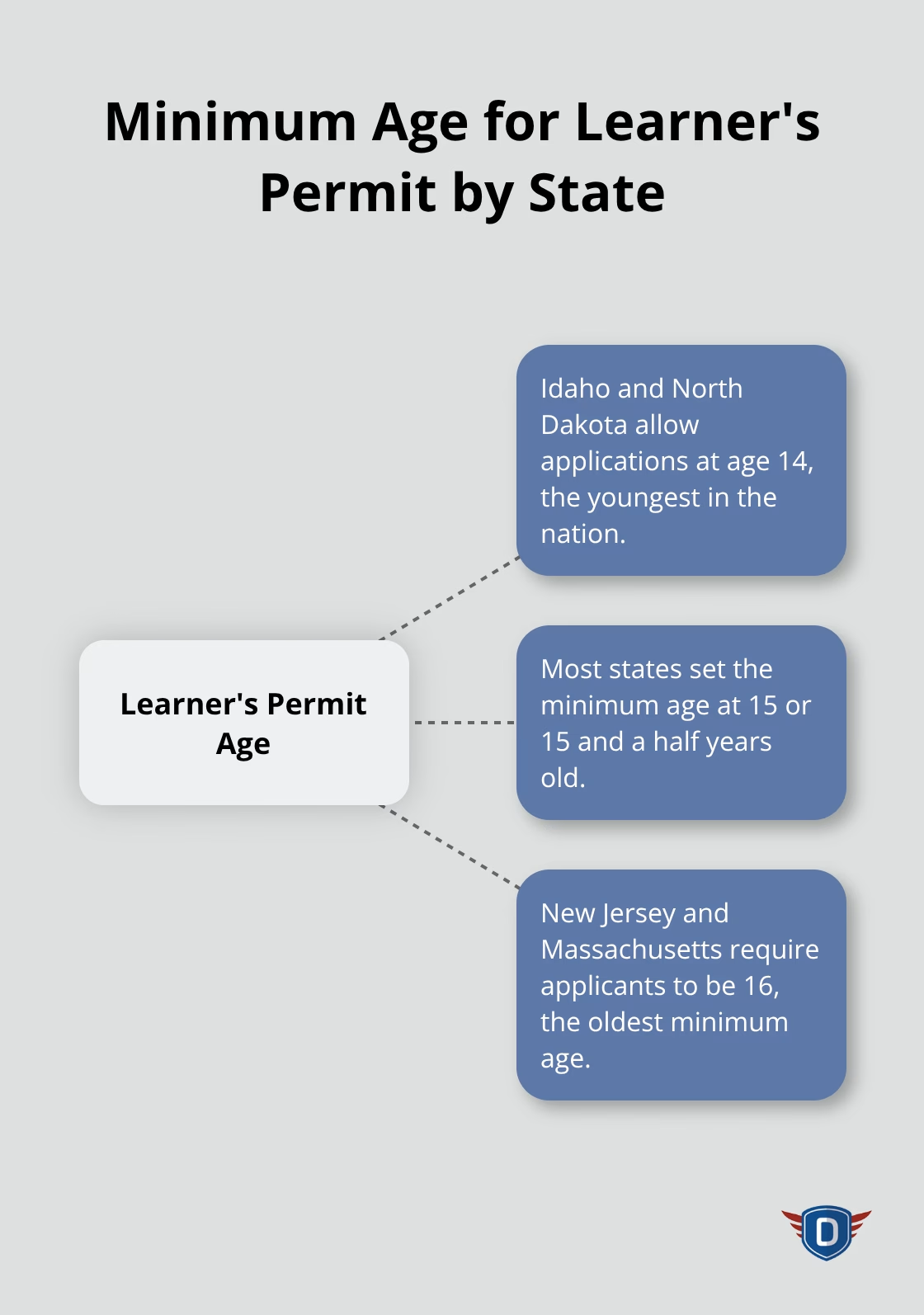
Additional Eligibility Criteria
Age isn’t the only factor in obtaining a learner’s permit. Many states have implemented additional requirements to ensure teens are prepared for the responsibility of driving. These often include:
- School Enrollment: Some states require teens to be enrolled in school or have completed a certain level of education.
- Driver’s Education: Many states mandate the completion of a driver’s education course before applying for a permit. These courses typically cover road rules, safe driving practices, and the dangers of impaired driving.
- Parental Consent: Most states require a parent or guardian’s signature on the permit application for minors.
State-Specific Variations
The specifics of learner’s permit requirements can differ greatly from state to state. For instance:
- California requires teens to be at least 15 years and 6 months old and complete a 30-hour driver’s education course before applying for a permit.
- Texas allows teens to begin the process at 14, but they must complete both classroom and behind-the-wheel training (totaling 66 hours).
- Florida requires teens to be 15 years old and complete a Driver Education Traffic Safety (DETS) course prior to obtaining a permit.
These variations can confuse teens and parents. We always recommend checking with your state’s Department of Motor Vehicles for the most up-to-date and accurate information.
Graduated Driver Licensing Programs
Some states have implemented Graduated Driver Licensing (GDL) programs. These programs typically involve a three-stage process: learner’s permit, intermediate license, and full license. Recent studies indicate that GDL programs are successful in reducing crash risks while teenage drivers are enrolled in the program.
Understanding and meeting these requirements plays a key role for teens eager to start their driving journey. While the process might seem complex, it aims to ensure that new drivers are well-prepared for the responsibilities that come with operating a vehicle.
Now that we’ve covered the age requirements and eligibility criteria, let’s move on to the next crucial step: the application process itself.
How to Apply for Your Learner’s Permit
Gathering Required Documents
Before you visit your local Department of Motor Vehicles (DMV), collect all the necessary paperwork. You’ll typically need:
- Proof of identity (California Identification Card or other proof of identity)
- Proof of residency
- Social Security number
- Proof of school enrollment or completion (in some states)
- Parental consent form (if under 18)
Check your state’s DMV website for a complete list of required documents, as requirements vary by location.
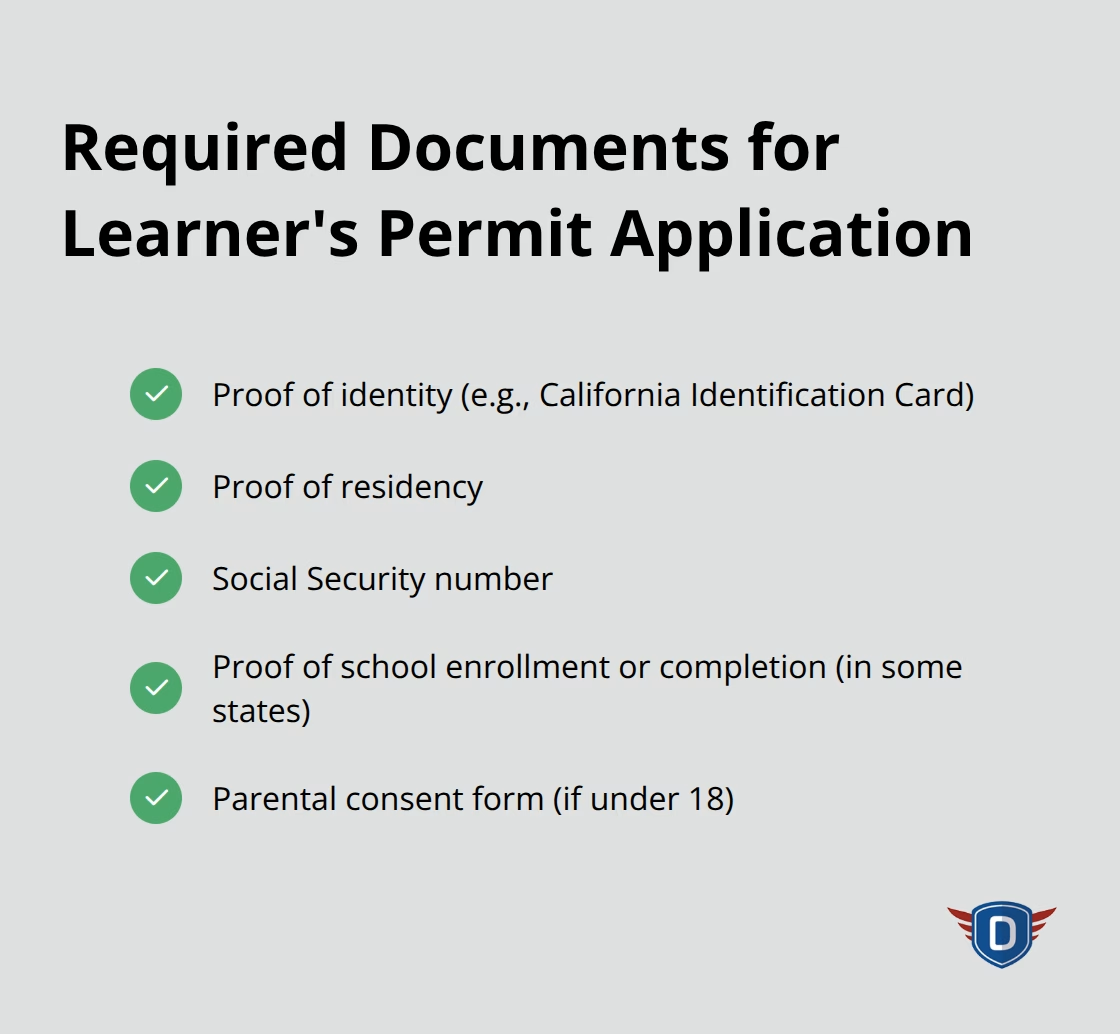
Preparing for the Written Test
The written test is a key component of obtaining your learner’s permit. It usually covers traffic laws, road signs, and safe driving practices. To prepare:
- Study your state’s driver’s handbook thoroughly
- Take online practice tests
- Use flashcards for road signs and rules
- Consider enrolling in a driver’s education course
The National Highway Traffic Safety Administration offers information on teen driving safety issues and provides links to states’ teen driver license requirements.
Vision Screening and Other Assessments
Most states require a vision test as part of the permit application process. Some may also conduct a basic physical assessment to ensure you’re fit to drive. If you wear corrective lenses, bring them to your appointment.
Understanding the Costs
Fees for obtaining a learner’s permit vary by state. On average, you can expect to pay between $20 and $80 for the permit itself. Additional costs may include:
- Driver’s education courses ($30 to $180)
- Study materials ($10 to $30)
- Vision test fees (if not included in the permit fee)
These costs may seem high, but proper education and preparation are essential for your safety on the road.
The application process marks the beginning of your journey to become a licensed driver. Stay focused, study hard, and ask for help when needed. Now that you understand how to apply for your learner’s permit, let’s explore the restrictions and responsibilities that come with it.
What Are the Rules for New Drivers?
Supervised Driving Requirements
When you have a learner’s permit, you must always drive with a licensed driver in the passenger seat next to you. This supervisor typically needs to be at least 21 years old (in some states, 25 or older) and must have held their license for a minimum of one year. The supervising driver will guide you, offer advice, and take control if necessary. You should ask questions and seek feedback on your driving skills during these sessions.
Time Restrictions for Driving
Many states impose curfews on learner’s permit holders. These restrictions often prohibit driving late at night (usually between 11 PM and 5 AM, though exact hours vary by state). These rules keep inexperienced drivers off the road during dangerous hours. A study found that the rate of driver fatalities was 5 times higher among 16- and 17-year-olds from 10 p.m. to 5:59 a.m. compared to driving during the day. Time restrictions also ensure that you gain experience in various daylight conditions before you tackle night driving.
Passenger Limitations
To reduce distractions, most states limit the number of passengers you can have in your car. Often, only your supervising driver is allowed. Some states permit immediate family members as additional passengers. These rules exist for good reason: studies show that for teen drivers, the risk of a fatal crash increases with each additional passenger. The AAA Foundation for Traffic Safety found that the risk of a fatal crash increases by 44% with one passenger under 21, doubles with two, and quadruples with three or more.
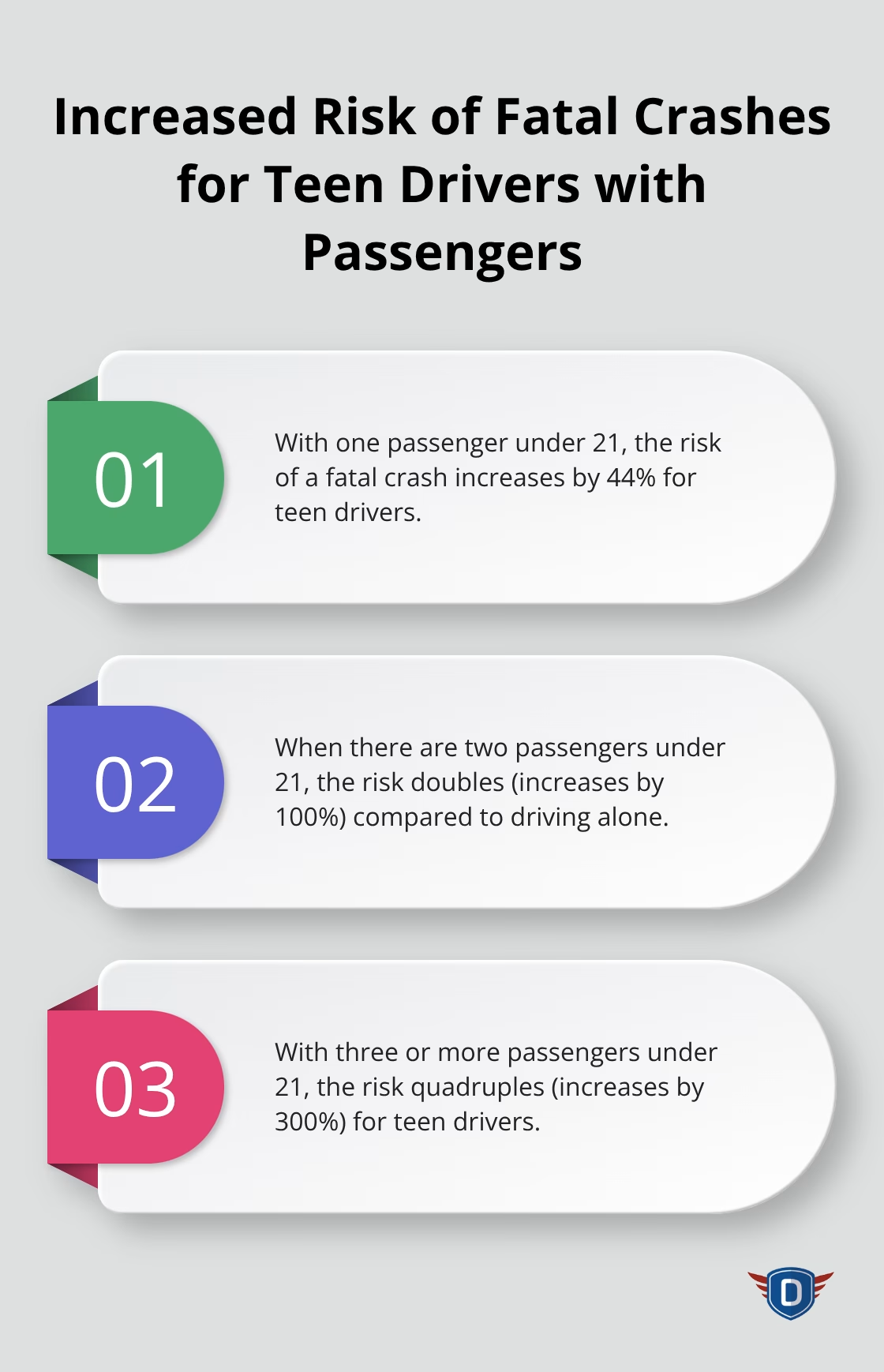
Zero Tolerance Policies
Rules for learner’s permit holders regarding traffic violations and substance use are strict. Many states have “zero tolerance” laws for underage drinking and driving. Numerous studies have shown that lowering the illegal per se law from .10 to .08 has been effective in reducing alcohol-related traffic fatalities. Even minor infractions can lead to the suspension or revocation of your permit. Some states use a point system, where accumulating too many points results in the loss of driving privileges.
Logging Practice Hours
Most states require learner’s permit holders to log a certain number of supervised driving hours before they can apply for a full license. This requirement typically ranges from 40 to 60 hours, with some states mandating additional nighttime driving practice. You should keep an accurate log of your driving hours using a dedicated logbook or a smartphone app. Note the date, duration, and conditions of each driving session. This log helps you meet state requirements and gives you a clear picture of your progress and areas that need more practice.
Final Thoughts
The transition from a learner’s permit to a full driver’s license requires dedication and practice. Most states mandate a minimum holding period for the learner’s permit, typically ranging from six months to a year. This time allows new drivers to gain valuable experience and confidence behind the wheel.
Preparing for the behind-the-wheel test is essential. You should practice regularly with a licensed adult, focusing on areas where you feel less confident. Common reasons for failing the driving test include improper lane changes, failing to check blind spots, and not maintaining a safe following distance.
At DriverEducators.com, we offer comprehensive driver education programs designed to help students master safe driving skills. Our new DETS course in Florida for 15-17 year-olds provides an excellent opportunity to fulfill state requirements and gain valuable knowledge about traffic safety (this course is specifically tailored for young drivers in the Sunshine State). You will find the tools and resources you need to become a responsible driver on our website.
